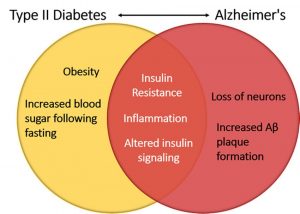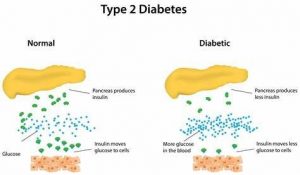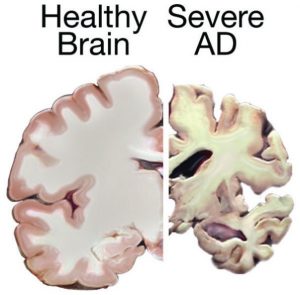https ://www.researchgate.net/figure/Insulin-signaling-linking-Type-II-diabetes-and-Alzheimers-disease-Alterations-in_fig4_323247347
://www.researchgate.net/figure/Insulin-signaling-linking-Type-II-diabetes-and-Alzheimers-disease-Alterations-in_fig4_323247347
Research has consistently found that there is a link between Type 2 Diabetes and Alzheimer’s Disease. People with one condition are more likely to develop one disease if they already have the other. What is happening here? A recent article by Vieira, Lima-Filho, and Felice advances the role of insulin resistance in Alzheimer’s Disease
https://www.ncbi.nlm.nih.gov/pubmed/29129775
What is Type 2 Diabetes? 
https://www.thermofisher.com/blog/proteomics/type-2-diabetes-metabolomics-reveals-lipid-dysregulation/
Type 2 Diabetes is characterized by insulin resistance in the body. When food is eaten, it is broken into glucose and enters the bloodstream. Insulin is released from the pancreas in response to glucose entering the bloodstream. Insulin’s job is to help cells absorb and use glucose. In Type 2 Diabetes, the cells become resistant to insulin and can no longer use the glucose in the body. This causes elevated blood sugar levels and starves the body’s cells of glucose. The figure above is a graphic representation of insulin resistance.
https://www.cdc.gov/diabetes/basics/type2.html
What is Alzheimer’s Disease?
https://ghr.nlm.nih.gov/condition/alzheimer-disease
Alzheimer’s is a neurodegenerative disease that causes a loss of cognitive function. The figure above shows a comparison of a healthy brain to the losses sustained through Alzheimer’s Disease. The two characteristic features of Alzheimer’s Disease are a buildup of neurofibrillary tangles and amyloid plaques. Amyloid plaques are formed when a larger protein is cleaved to form amyloid-beta. One potential form of this smaller protein, AB42, is harmful to the brain. In normal brains, AB42 is formed in relatively small amounts and can be cleared. In Alzheimer’s this process does not occur and amyloid-beta builds up and forms plaques in the brain. Neurofibrillary tangles occur when proteins known as tau begin to misfunction. In healthy brains, tau is a part of the microtubule system in cells that acts like a railroad system in the cell. In Alzheimer’s, tau detaches from the microtubules and builds up in the brain and disrupts functioning.
https://www.nia.nih.gov/health/what-happens-brain-alzheimers-disease
Insulin Resistance in Alzheimer’s
The article mentioned at the beginning of my post investigated the role of insulin resistance in Alzheimer’s Disease. Researchers have found that insulin resistance appears to occur in the brain in the case of Alzheimer’s. As I mentioned, insulin resistance causes cells to starve because they cannot use the glucose that is in the bloodstream. The existence of this phenomenon in the brain can cause the death of neurons in the brain because they are not receiving proper nutrients. It would be irresponsible to suggest this as the absolute cause of Alzheimer’s. As a result, below I outline some other mechanisms and potential causes recognized in current research.
The Role of Inflammation
Inflammation occurs as an immune system response. In the brain, the cells that act as a part of the immune system are microglia. The microglia make attempts to clear the amyloid plaques that have built up, but for reasons that are still debated are unable to. This can be harmful to the brain because microglia can inadvertently harm healthy cells within the brain when they try to eliminate amyloid plaques. This can contribute to cell death within the brain
Endoplasmic Reticulum Stress
The endoplasmic reticulum is an organelle that is responsible for folding proteins. This is important because the amyloid-beta protein that is made within the brain travels to the endoplasmic reticulum to be folded. The endoplasmic reticulum is very sensitive to changes in the cell’s natural state and will not function properly when under stress. This means that the amyloid-beta protein is likely to be misfolded and contribute to the amyloid plaques. It is currently unclear what causes endoplasmic reticulum stress, some possible factors could be the existing disease pathology, inflammation, or aging.
https://royalsocietypublishing.org/doi/full/10.1098/rsob.180024
Conclusion
There appears to be a strong link between Alzheimer’s and Type 2 Diabetes. This potentially leads back to Alzheimer’s Disease involving insulin resistance in the brain. There are a lot of other factors at play in the development of Alzheimer’s, including inflammation responses and cellular stress. Continued research will hopefully answer some questions but will likely bring in more questions about why some people develop Alzheimer’s Disease.